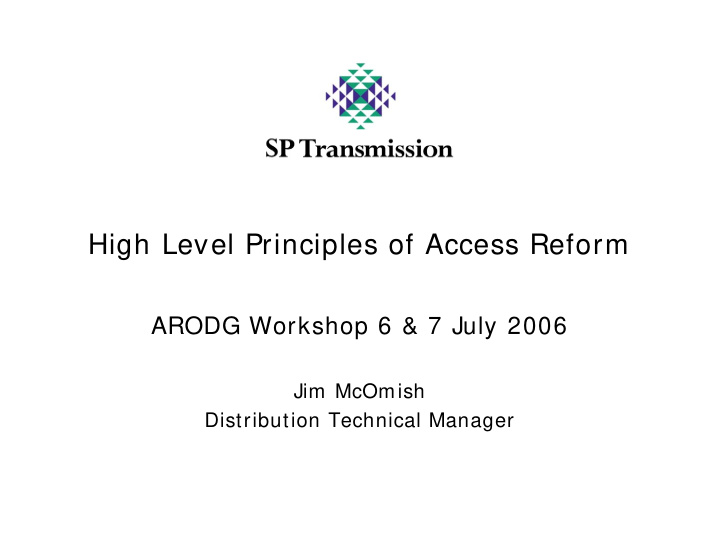



High Level Principles of Access Reform ARODG Workshop 6 & 7 July 2006 Jim McOmish Distribution Technical Manager
High Level Principles • Simple coordinated solutions • Timetable matching TPCR4 • Retention of price signals • Recognising practical constraints • Strategic investment decisions required • Appropriate and effective transfer of risk between users
Simple Solutions • Degree of change – Proportionate to extent of problems – Minimum change – Benefits outweighing costs – Improvement to enduring arrangements rather than short term fix – Achievable in relatively short timescales • Need for co-ordination – Role for Ofgem / ARODG
Change Timetable • Timetable for change consistent with TPCR4 • Potential interactions include – Timing of investments relative to timing of revenues – Change to risk profile – Financeability – Cost of Capital • Transitional arrangements may be required • Potential for TPCR4 reopeners
Price Signals • National Grid shallow connection charges – No within zone location price signal – Limited price signal for security of connection • Final Sums Liabilities – Less effective than deep connection charges but currently provide only price signal for • Within zone location • Degree of security of connection (single or dbl. cct.) • Certainty of project completion • Appropriate price signal must form part of solution – Avoid increased risk of unnecessary investment
Recognising Practical Constraints • Several practical constraints on TEC delivery – Planning consents & landowner permissions • Substantially out with transmission companies control – Scotland – England & Wales interconnector (Boundary B6) • Contractually constrained pre BETTA • Physical network constraint post BETTA • Below current required capacity – BETTA transitional arrangements • TEC rights independent of Boundary B6 upgrades compound existing physical constraint • Risk of windfall gains for generators
Boundary Reinforcement Scotland (SHETL) B4 B5 B6 Scotland (SPT) England and Wales (NGET)
Required B6 Boundary Capability 6000 5000 4000 Transfer ( MW ) 3000 2000 1000 0 2005/ 06 2006/ 07 2007/ 08 2008/ 09 2009/ 10 2010/ 11 2011/ 12 2012/ 13 2013/ 14 50% Range Required Capability (Base Planning Assumptions) Proposed Capability 90% Range
Strategic Investment Decisions • Transmission infrastructure investment and capacity release – Lumpy in nature – Non-linear cost: capacity relationship – Inappropriate to trigger investments and revenues purely on User Commitments • Strategic investment decisions informed rather than constrained by User Commitments are required to deliver most economic network solutions – Collector stations – Inter-area boundary reinforcements – In area reinforcements
Appropriate Transfer of Risk • Users ultimately benefit from efficient investment decisions and effective market entry • Appropriate that new and the existing user community should share proportionately the risk of under-utilised shared infrastructure – e.g. collector stations • New generators should continue to underwrite the full stranding risk of sole use assets (infrastructure and connection) – 100% FSL for sole use assets
Recommend
More recommend